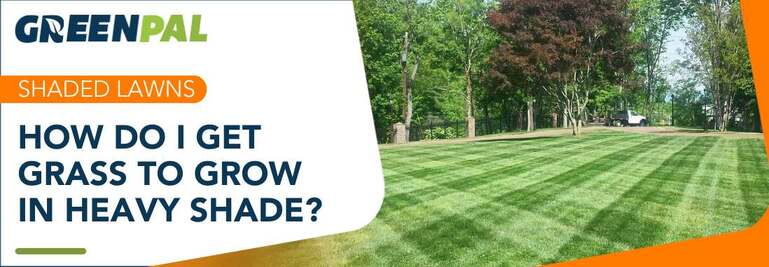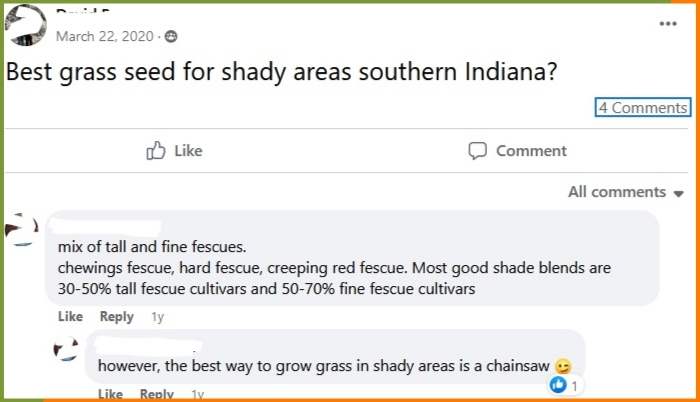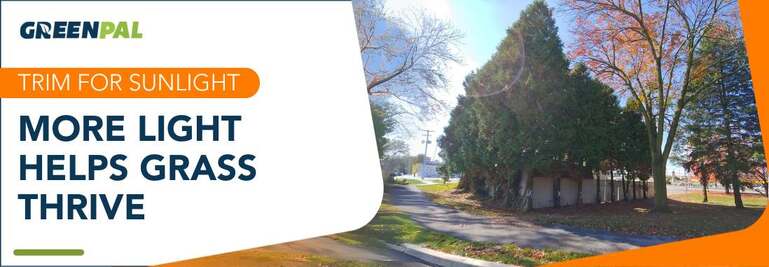How do I get a lawn growing in heavy shade?

Have a lawn that doesn't get much light?
Don't worry; I have been there as well.
And fortunately, there are a few simple solutions you can use to get your lawn lush and green, even in a shady location.
If that sounds like a plan…
Then let's take a look at these easy to follow methods to grow grass in a low light lawn below!
Grass Selection For Shady Area
One of the first steps to getting a green lawn in a shady location is selecting the correct grass type.
So what are the best types of grass for a shady lawn?
Here are a few of the best low-light grasses:
1. Zoysia: Like St. Augustine, Zoysia is a warm-season grass that grows well in both sun and shade.
2. Fine-leaf fescue: Fine fescue is a cool season grass that is drought tolerant and will even grow in poor quality soils.
3. St. Augustine: St. Augustine is a southeastern favorite and grows tremendously well in warm areas.
4. Perennial ryegrass: Ryegrass is a cheap option that grows in partly shaded areas.
5. Bahai: Grows well in moderate shade and handles many different soil types.
What is the Best Shade Grass for Warm Climates?
According to Pennington, zoysia is the best warm season grass for shady spaces.
Top Cool Season Grasses for Shady Areas
For cooler climates is likely going to be a mix of fescues. Some landscapers report simply buying several grass seed types available locally and mixing them for best results.

Methods to Improve the Quality of a Low-light Lawn
While selecting the best type of grass for a low-light area will get your foot in the door...
If you really want your lawn to shine in a shady area, you need to take a few extra steps.
Compost and Fertilize
Look, fertilizing is always important if you really want a healthy and lush lawn. But when it comes to making a shady lawn greener, it's even more important.
In general, you should top dress your lawn with compost annually. Preferably in the spring, so your lawn care gets the nutrients it will need throughout the growing season.
Additionally, you should fertilize your lawn in the spring and winter.
What type of fertilizer is best for grass in shaded areas?
Fertilizers low in nitrogen and high in potassium are best for shaded grass. This combination helps the grass tolerate lower light conditions and strengthens its resistance against diseases.

Aerate and Overseed Annually
Here's the deal, like most of these tips, you should try to aerate and overseed a lawn whether or not it is in a shady area.
But when it comes to growing a healthy lawn in a place that gets very little light, annual aeration and overseeding becomes more important.
Additionally, the overseeding will fill out any of the thinner patches of grass in the lawn, which shaded lawns are prone to.
When is the best time to overseed a shaded lawn?
Early fall is ideal, as it allows grass seeds to establish before the onset of winter.
Don't Overwater
When it comes to watering a shady lawn, you won't need to water as frequently or as long as water is less likely to evaporate.
Therefore, you are more likely to find yourself overwatering your lawn if you have a shady yard. Overwatering your property could cause diseases or mold to kill your grass.
But at least you can relax knowing that you can conserve some water and save some money on your water bill.
Trim or Remove Your Trees
If you haven't already, you may want to trim your trees back to allow more sunlight to reach your lawn.
The reality is, growing a perfect lawn in a shady spot can be challenging. So if you can trim your trees back to allow more sunlight in, you may have an easier time maintaining your lawn.
Of course, there is always the option of removing trees entirely, but this option should be carefully considered, as trees can add a lot of value and privacy to your home.
Consider Alternatives
At the end of the day, you may want to consider alternatives to a grassy lawn. After all, maintaining a property in a shady space can be a bit of a hassle.
So some consider alternatives such as:
Synthetic turf,
Or a moss lawn.

FAQ: How do I get a lawn growing in heavy shade?
How do I determine how much sun my shady areas actually get?
- Watch the area throughout the day to note when and for how long sunlight reaches it.
- Use a sunlight meter for accurate measurements.
- Track shadow movements to understand sunlight patterns.
- Observe plant growth - stretching or leaning plants may indicate insufficient light.
- Measure light intensity with a meter (in foot-candles or lux) for precise data.
- Ask local gardening groups or extension services for region-specific advice.
How does limited sunlight affect grass growth?
Limited sunlight reduces the rate of photosynthesis, which can stunt growth and lead to thinner, less vigorous lawns.
What are some tips to prevent fungal diseases in shaded lawns?
Ensure adequate airflow, avoid overwatering, and remove thatch to prevent moisture buildup that leads to disease.
Wrapup: Growing Grass in A Shady Lawn Wrapup
If you select the right grass type, you can grow grass in shady areas when it comes down to it. But you will have to be on top of it.
The grass may not take as quickly as it would in a sunny area, and it will be more susceptible to disease.
That is why many opt to try an alternative to the traditional American lawn.
On the bright side, you won't have to water as much!
Either way, we hope you found what you needed, and you can find many more articles just like this one at our Homeowner Lawn Care Blog.





 Share
Share













